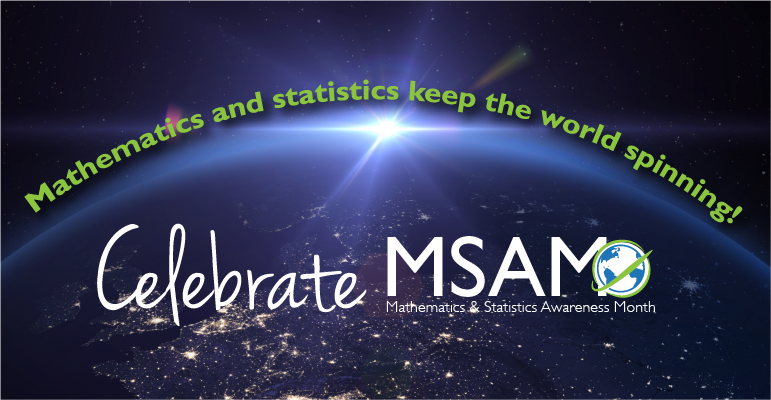Mathematics and Statistics Awareness Month

Activities
We encourage colleges and universities—and also high-school departments, institutional public information offices, math clubs, and student groups—and related associations and interest groups to organize and host activities in April for Mathematics and Statistics Awareness Month. Past activities have included workshops, competitions, exhibits, festivals, lectures, symposia, department open houses, math art exhibits, and math poetry readings. Some years, elected officials have issued proclamations, frequently in connection with special meetings and events arranged to observe the month.
This year, due to the coronavirus forcing schools to close and making it difficult to gather, we encourage you to celebrate mathematics and statistics on social media. Share your favorite math books, games, T-shirt designs, posters, news stories, videos, and research using hashtag #MathStatMonth.
Read about the origins of Mathematics and Statistics Awareness Month.
April marks a time to increase the understanding and appreciation of mathematics and statistics.
Why? Both subjects play a significant role in addressing many real-world problems—internet security, sustainability, disease, climate change, the data deluge, and much more. Research in these and other areas is ongoing, revealing new results and applications every day in fields such as medicine, manufacturing, energy, biotechnology, and business. Mathematics and statistics are important drivers of innovation in our technological world, in which new systems and methodologies continue to become more complex.
Basic research in mathematics is valuable in itself, but it often contributes to research in other sciences and has often, years later, led to discoveries that affect society today. For example, an encryption algorithm used today in e-commerce relies on results discovered in the 17th and 18th centuries, long before computers were invented. Mathematics has inspired some of the most stunning architecture and art.
In the age of big data, statistics underlies almost every decision made today, whether it's the effectiveness of a new drug or treatment or the debut of a new mobile device. Statistics is how analysts convert raw data into useful information, from studies of proteins to surveys of galaxies.
Research in statistics and the mathematical sciences is important for its applications and because it trains one in critical thinking and problem solving. From magic squares and Möbius bands to magical card tricks and illusions, mysterious phenomena with elegant "Aha!" explanations have been part of both subjects for centuries.
This April, let's celebrate mathematics and statistics and the diverse researchers and students in these fields who are contributing so much to furthering discoveries, solving problems, and finding beauty in our world.
The following suggestions are for bringing Mathematics and Statistics Awareness Month to the attention of the general public by using some of your local media outlets. The more you are able to provide a local angle (such as getting an MSAM proclamation from your mayor or governor, involving a local high school or college, etc.), the more likely you are to receive local coverage.
Public Information Office
Contact your institution's public information office (PIO) and ask to have your events included in their various calendar announcements. The PIO is likely to have good contacts with local media and may be able to help you get media coverage. You may also want to discuss the following ideas with your PIO staff.
Newspaper Editorials or Letters to the Editor
Newspapers (especially weekly ones) may run an editorial recognizing MSAM if it is signed by a local professor or public policy representative. Restrict the focus to one topic, such as changes in math or statistics courses in your department, selected research projects at your institution over the last decade, how skills in mathematics and statistics can increase career options in all fields, etc. Mention your local events briefly as part of the editorial. Keep it to 300 or so words in length. Letters to the Editor are appropriate when you can respond to a recently published story and mention mathematics, statistics, and/or MSAM as part of the reply. Follow carefully the guidelines for letters to the editor provided by your paper—often on the editorial page.
Radio-TV Public Service Announcements
Radio and television stations may run PSAs of 10, 20, and 30 seconds in length. The script could focus on Mathematics and Statistics Awareness Month in general or specifically on your local events. You must provide at least one good slide with 10–, 20–, and 30–second scripts as part of requesting a local TV station to run your PSA. It helps to have the materials and request come from a local institution.
Sample 10-Second Script
The University of invites you to join in celebrating Mathematics and Statistics Awareness Month this April. Mathematics and statistics give us new discoveries and offer students many career options. Explore mathematics and statistics at ww2.amstat.org/mathstatmonth (or provide your own URL—the simpler, the better).
Cable TV
Cable television companies have local access channels that will make 30-minute blocks of time available. Propose a panel discussion to your local cable company on a topic such as “Careers in Mathematics and Statistics.” Provide a list of spokespersons, their institutions, and a few specific ideas about what you could discuss.